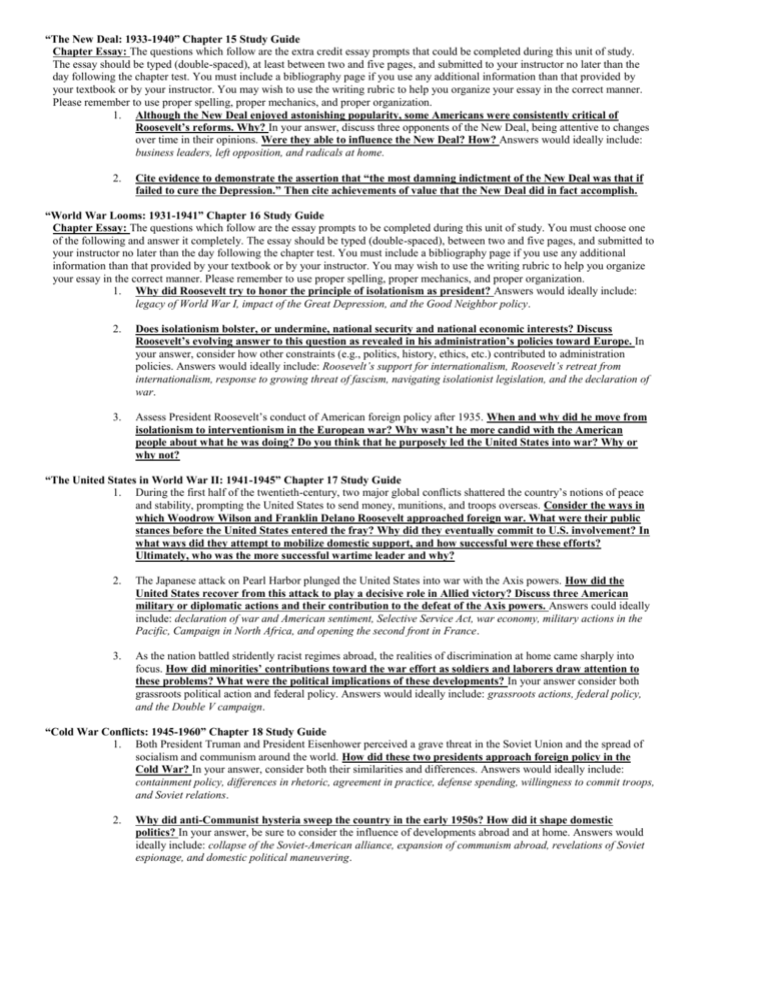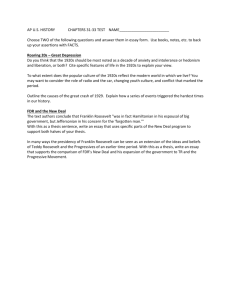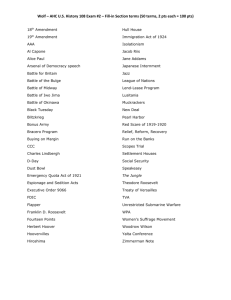“The New Deal: 1933-1940” Chapter 15 Study Guide
advertisement

“The New Deal: 1933-1940” Chapter 15 Study Guide Chapter Essay: The questions which follow are the extra credit essay prompts that could be completed during this unit of study. The essay should be typed (double-spaced), at least between two and five pages, and submitted to your instructor no later than the day following the chapter test. You must include a bibliography page if you use any additional information than that provided by your textbook or by your instructor. You may wish to use the writing rubric to help you organize your essay in the correct manner. Please remember to use proper spelling, proper mechanics, and proper organization. 1. Although the New Deal enjoyed astonishing popularity, some Americans were consistently critical of Roosevelt’s reforms. Why? In your answer, discuss three opponents of the New Deal, being attentive to changes over time in their opinions. Were they able to influence the New Deal? How? Answers would ideally include: business leaders, left opposition, and radicals at home. 2. Cite evidence to demonstrate the assertion that “the most damning indictment of the New Deal was that if failed to cure the Depression.” Then cite achievements of value that the New Deal did in fact accomplish. “World War Looms: 1931-1941” Chapter 16 Study Guide Chapter Essay: The questions which follow are the essay prompts to be completed during this unit of study. You must choose one of the following and answer it completely. The essay should be typed (double-spaced), between two and five pages, and submitted to your instructor no later than the day following the chapter test. You must include a bibliography page if you use any additional information than that provided by your textbook or by your instructor. You may wish to use the writing rubric to help you organize your essay in the correct manner. Please remember to use proper spelling, proper mechanics, and proper organization. 1. Why did Roosevelt try to honor the principle of isolationism as president? Answers would ideally include: legacy of World War I, impact of the Great Depression, and the Good Neighbor policy. 2. Does isolationism bolster, or undermine, national security and national economic interests? Discuss Roosevelt’s evolving answer to this question as revealed in his administration’s policies toward Europe. In your answer, consider how other constraints (e.g., politics, history, ethics, etc.) contributed to administration policies. Answers would ideally include: Roosevelt’s support for internationalism, Roosevelt’s retreat from internationalism, response to growing threat of fascism, navigating isolationist legislation, and the declaration of war. 3. Assess President Roosevelt’s conduct of American foreign policy after 1935. When and why did he move from isolationism to interventionism in the European war? Why wasn’t he more candid with the American people about what he was doing? Do you think that he purposely led the United States into war? Why or why not? “The United States in World War II: 1941-1945” Chapter 17 Study Guide 1. During the first half of the twentieth-century, two major global conflicts shattered the country’s notions of peace and stability, prompting the United States to send money, munitions, and troops overseas. Consider the ways in which Woodrow Wilson and Franklin Delano Roosevelt approached foreign war. What were their public stances before the United States entered the fray? Why did they eventually commit to U.S. involvement? In what ways did they attempt to mobilize domestic support, and how successful were these efforts? Ultimately, who was the more successful wartime leader and why? 2. The Japanese attack on Pearl Harbor plunged the United States into war with the Axis powers. How did the United States recover from this attack to play a decisive role in Allied victory? Discuss three American military or diplomatic actions and their contribution to the defeat of the Axis powers. Answers could ideally include: declaration of war and American sentiment, Selective Service Act, war economy, military actions in the Pacific, Campaign in North Africa, and opening the second front in France. 3. As the nation battled stridently racist regimes abroad, the realities of discrimination at home came sharply into focus. How did minorities’ contributions toward the war effort as soldiers and laborers draw attention to these problems? What were the political implications of these developments? In your answer consider both grassroots political action and federal policy. Answers would ideally include: grassroots actions, federal policy, and the Double V campaign. “Cold War Conflicts: 1945-1960” Chapter 18 Study Guide 1. Both President Truman and President Eisenhower perceived a grave threat in the Soviet Union and the spread of socialism and communism around the world. How did these two presidents approach foreign policy in the Cold War? In your answer, consider both their similarities and differences. Answers would ideally include: containment policy, differences in rhetoric, agreement in practice, defense spending, willingness to commit troops, and Soviet relations. 2. Why did anti-Communist hysteria sweep the country in the early 1950s? How did it shape domestic politics? In your answer, be sure to consider the influence of developments abroad and at home. Answers would ideally include: collapse of the Soviet-American alliance, expansion of communism abroad, revelations of Soviet espionage, and domestic political maneuvering.









